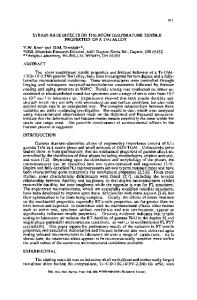The Effects of Strain Rate and Minor Baron Addition on Brittle-to-Ductile Transition Temperature in Gamma TiAl Alloy
- PDF / 2,389,926 Bytes
- 8 Pages / 414.9 x 643.14 pts Page_size
- 59 Downloads / 258 Views
Dongliang Lin (T. L. Lin)', Yu Wang', Junliang Liu', and Chi C. Law l) School of Materials Science and Engineering, Shanghai Jiao Tong University, Shanghai, 200030 P R. China 2)Materials & Mechanics Engineering, United Technologies-Pratt & Whitney, East Hartford, Connecticut, 06108, U. S. A. ABSTRACT Brittle-to-ductile transition (BDT) temperature (TBD) was evaluated according to temperature dependence of tensile properties under different strain rates from 10-5 to 10-' s- in two-phase Ti-47Al2Mn-2Nb and Ti-47A1-2Mn-2Nb-0.8TiB 2 alloys with nearly lamellar microstructure. Based on the strain rate dependence of the determined TBD values, apparent BDT activation energies were determined using Zener-Hollomon factor. Tensile fracture surfaces were observed using a scanning electron microscope while deformation substructures were investigated by transmission electron microscopy. It was found that the BDTT of both alloys increased sharply with the strain rate and that the minor addition of 0.8 vol% TiB 2 reduced TBD by about 100K at the same strain rate. The TiB 2 addition also decreases the apparent BDT activation energy from 324 to 256 kJ/mol. Both of these values approximate to self- or inter-diffusion of Ti and Al atoms in TiAI phase. Transgranular fracture and dimple fracture were found dominant in fracture surfaces below and above TBD, respectively. The most common 1/21373 K TiAlMnNbB alloy 885 980 1015 1110 1310 Table I shows that the small boron addition reduces the TBD value by more than 100K, and that for both alloys, TBD values depend positively on the strain rate: it rises from 1023K to more than 1373K for TiAlMnNb alloy, and from 885K to 1310K for TiAlMnNbB alloy when the strain rate is increased from 10-'s-1 to 10-'s-'. The effect of strain rate on tensile properties Fig. 4 exhibits the variation of tensile properties of the two alloys with strain rate at two typical high temperatures, respectively. As the strain rate increases, 12(0.2 increases monotonically while 8 decreases steadily down to a brittle level (
Data Loading...











